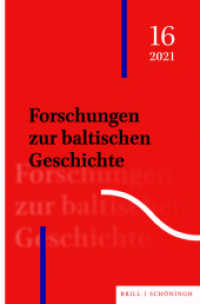- ホーム
- > 洋書
- > 英文書
- > Science / Mathematics
Full Description
Quasibrittle (or brittle heterogeneous) materials are becoming increasingly important for modern engineering. They include concretes, rocks, fiber composites, tough ceramics, sea ice, bone, wood, stiff soils, rigid foams, glass, dental and biomaterials, as well as all brittle materials on the micro or nano scale. Their salient feature is that the fracture process zone size is non-negligible compared to the structural dimensions. This causes intricate energetic and statistical size effects and leads to size-dependent probability distribution of strength, transitional between Gaussian and Weibullian. The ensuing difficult challenges for safe design are vanquished in this book, which features a rigorous theory with detailed derivations yet no superfluous mathematical sophistication; extensive experimental verifications; and realistic approximations for design. A wide range of subjects is covered, including probabilistic fracture kinetics at nanoscale, multiscale transition, statistics of structural strength and lifetime, size effect, reliability indices, safety factors, and ramification to gate dielectrics breakdown.
Contents
1. Introduction; 2. Review of classical statistical theory of structural strength and structural safety, and of classical fundamentals; 3. Review of fracture mechanics and deterministic size effect in quasibrittle structures; 4. Failure statistics of nanoscale structures; 5. Nano-macro scale bridging of probability distributions of static and fatigue strengths; 6. Multiscale modeling of fracture kinetics and size effect under static and cyclic fatigue; 7. Size effect on probability distributions of strength and lifetime of quasibrittle structures; 8. Computation of probability distributions of structural strength and lifetime; 9. Indirect determination of strength statistics of quasibrittle structures; 10. Statistical distribution and size effect on residual strength after sustained load; 11. Size effect on reliability indices and safety factors; 12. Crack length effect on scaling of structural strength and type 1 to 2 transition; 13. Effect of stress singularities on scaling of structural strength; 14. Lifetime of high-k gate dielectrics and its analogy with failure statistics of quasibrittle structures.








